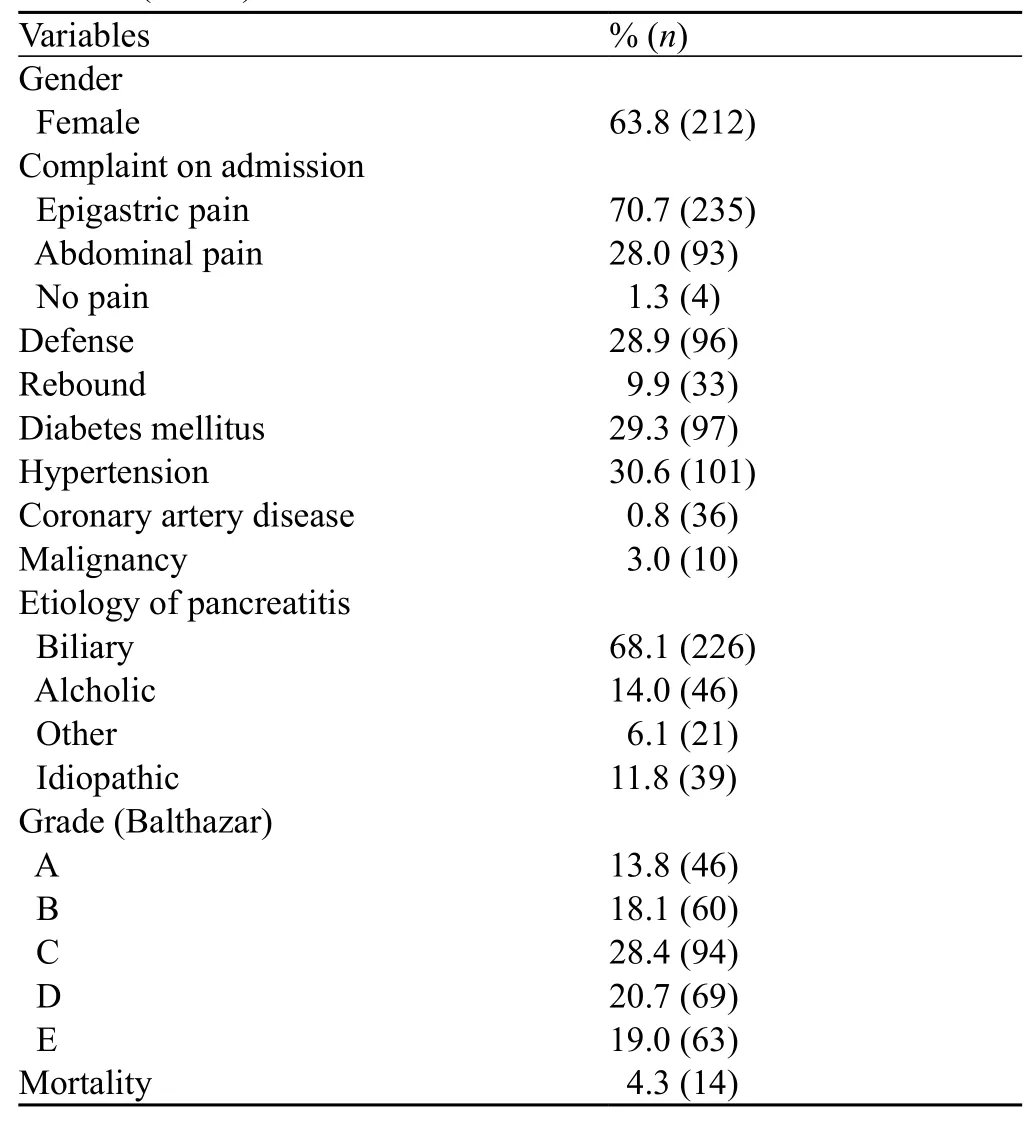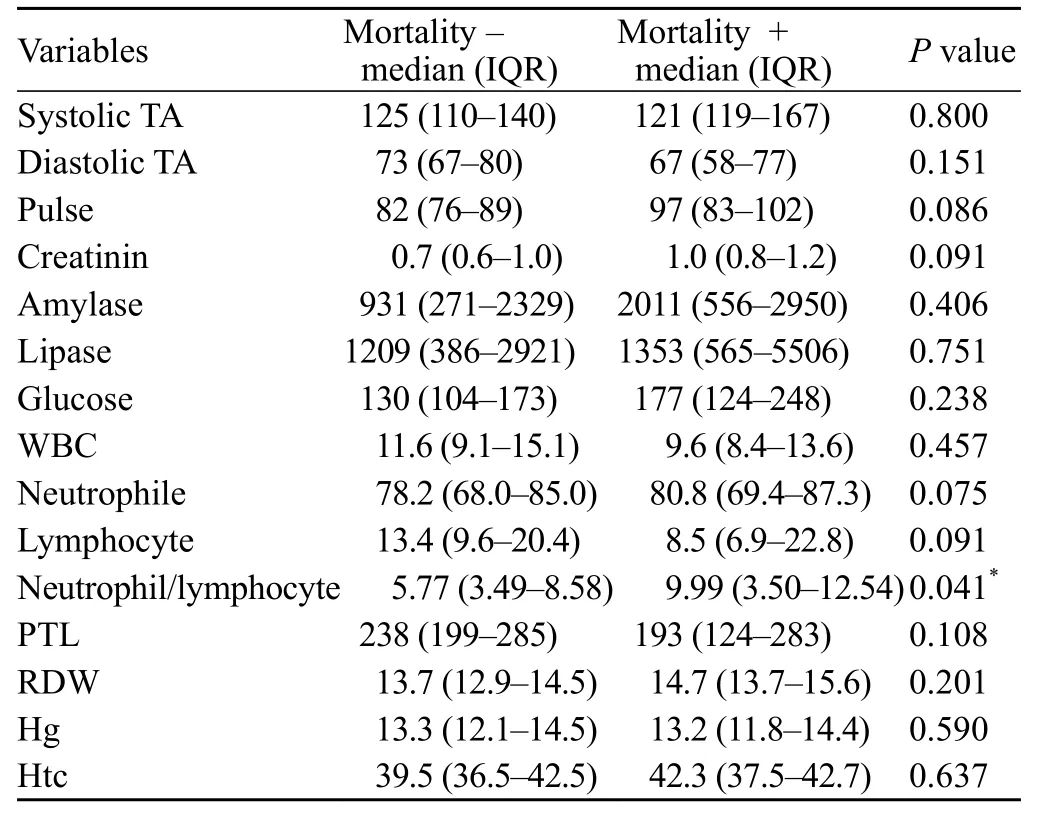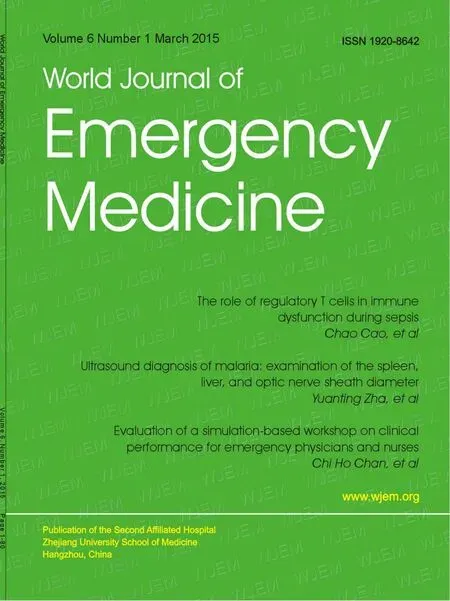Effect of harmless acute pancreatitis score, red cell distribution width and neutrophil/lymphocyte ratio on the mortality of patients with nontraumatic acute pancreatitis at the emergency department
Bedia Gülen, Ertan Sonmez, Serpil Yaylaci, Mustafa Serinken, Cenker Eken, Ali Dur, Figen Tunali Turkdogan, Özgür Söğüt
1Department of Emergency Medicine, Bezmialem Vakif University Medical Faculty, Istanbul, Turkey
2Department of Emergency Medicine, Acibadem University Hospital, Istanbul, Turkey
3Department of Emergency Medicine, Pamukkale University Medical Faculty, Denizli, Turkey
4Department of Emergency Medicine, Akdeniz University Medical Faculty, Antalya, Turkey
5Department of Radiology, Bayrampaşa State Hospital, Istanbul, Turkey
Effect of harmless acute pancreatitis score, red cell distribution width and neutrophil/lymphocyte ratio on the mortality of patients with nontraumatic acute pancreatitis at the emergency department
Bedia Gülen1, Ertan Sonmez1, Serpil Yaylaci2, Mustafa Serinken3, Cenker Eken4, Ali Dur1, Figen Tunali Turkdogan5, Özgür Söğüt1
1Department of Emergency Medicine, Bezmialem Vakif University Medical Faculty, Istanbul, Turkey
2Department of Emergency Medicine, Acibadem University Hospital, Istanbul, Turkey
3Department of Emergency Medicine, Pamukkale University Medical Faculty, Denizli, Turkey
4Department of Emergency Medicine, Akdeniz University Medical Faculty, Antalya, Turkey
5Department of Radiology, Bayrampaşa State Hospital, Istanbul, Turkey
BACKGROUND:Harmless acute pancreatitis score (HAPS), neutrophile/lymphocyte ratio and red blood cell distribution width (RDW) are used to determine the early prognosis of patients diagnosed with nontraumatic acute pancreatitis in the emergency department (ED).
METHODS:Patients diagnosed with acute pancreatitis (K 85.9) in the ED according to the ICD10 coding during one year were included in the study. Patients with chronic pancreatitis and those who had missing data in their files were excluded from the study. Patients who did not have computed tomography (CT) in the ED were not included in the study.
RESULTS:Ultimately, 322 patients were included in the study. The median age of the patients was 53.1 (IQR=36–64). Of the patients, 68.1% (n=226) had etiological causes of the biliary tract. The mortality rate of these patients within the f rst 48 hours was 4.3% (n=14). In the logistic regression analysis performed by using Balthazar classification, HAPS score, RDW, neutrophile/lymphocyte ratio, age, diabetes mellitus and systolic blood pressure, the only independent variable in determining mortality was assigned as Balthazar classif cation (OR: 15; 95%CI: 3.5 to 64.4).
CONCLUSIONS:HAPS, neutrophile/lymphocyte ratio and RDW were not effective in determining the mortality of nontraumatic acute pancreatitis cases within the f rst 48 hours. The only independent variable for determining the mortality was Balthazar classif cation.
Acute pancreatitis; Mortality; Balthazar; Emergency department
INTRODUCTION
Acute pancreatitis (AP) is characterized by the destruction and inf ammation of pancreas tissue through the activation of pancreatic acinar cells as a result of being triggered by various factors and it can cause significant morbidity and mortality. The patients who come to the emergency service with a complaint of acute stomach ache and who are diagnosed with acute pancreatitis through clinical, laboratorial and radiological screening methods should be assessed quickly. Forming risk def ning systems and determining the severity of the disease are of great importance in prognosis and how successful the treatment is. In the literature, it has been stated that indicators such as the Ranson criteria and computed tomography (CT) can be used to determine the severity of AP.[1,2]
The uncertainty of biochemical parameters and scoring systems that can be used alone within the first 48-hour prognosis of patients hospitalized for abdominal ache and diagnosed with acute pancreatitis is the leading clinical problem.
Within 30 minutes of admission, harmless acute pancreatitis score (HAPS) can be calculated in the patients and three parameters were taken into consideration: normal hematocrit, normal serum creatinine, and lack of rebound tenderness or guarding. Although it was not clearly described in the report, the patients were supposedly expected to have a harmless course in the absence of the three parameters.[3]
Red cell distribution width (RDW) is a calculable measure of variability in the volume of circulating erythrocyte, and higher values signify greater heterogeneity in cell sizes (ie, anisocytosis). As a part of complete blood count test, it is used in the assessment of patient's disorder, and it is an easy, inexpensive, and routinely reported parameter. RDW is a significant prognostic marker for determining the risk of mortality in a range of clinical manifestations.[4]
The neutrophil–lymphocyte ratio (NLR) which is calculated from the white cell differential count gives a rapid manifestation of the extent of an inflammatory process. Suppiah et al[5]reported that in patients with AP, elevated NLR can effectively differentiate patients with mild and severe AP.
The present study examined the effect of HAPS, NLR and RDW on mortality, which are used to determine the early prognosis (the first 48 hours) of patients with nontraumatic AP.
METHODS
The study was conducted in an adult emergency service of a university where 324 000 patients are admitted annually. It was approved by the Ethical Board of Bezmialem Foundation University, and the patients who came to the emergency service and diagnosed with acute pancreatitis were scanned retrospectively. The patients who were diagnosed with acute pancreatitis (K 85.9) according to the ICD10 coding system between January 2013 and December 2013 were included in the study. The data were taken from the patient files in the hospital's computer system and from radiology reports.
The criteria for inclusion were as follows: >16 years of age; admission to the emergency service within 24-hour complaining; patients undergoing CT at the emergency service; and patients with no history of trauma.
Characteristic signs and symptoms (upper abdominal pain with or without guarding and/or rebound tenderness, increased serum enzyme levels, and abnormal findings on contrast-enhanced CT) were used for the diagnosis of AP.
Patients with chronic pancreatitis and those who had missing data in their f les were excluded from the study. In addition, patients who were not subjected to CT for the diagnosis at the ED were not enrolled in the study.
The CT results of the patients who were included in the study were reassessed by an experienced radiology expert according to the Balthazar criteria. The grades for the appearance on CT were as follows: normal CT (grade A, 0 points), focal or diffuse pancreatic enlargement (grade B, 1 point), peripancreatic inf ammation or gland abnormalities (grade C, 2 points), single f uid collection (grade D, 3 points), and two or more f uid collections or adjacent gas bubbles (grade E, 4 points).[6]
The HAPSs of the patients within 30 minutes of admission to the ED were calculated according to the findings of peritonitis (defence/rebound) in physical treatment and the laboratory values (hematocrit, creatine) at the time of admission.
Statistical analysis
SPSS 17.0 and MedCalc softwares were used for data analysis. Numeric variables were presented as median and interquartile range, and categorical rates. The Mann-Whitney U test and the Chi-square test were used for the comparison of the two groups. The Kolmogorov-Smirnov test was used for the analysis of normality. For determination of independent variables in predictingmortality, logistic regression analysis was performed. The hypothesis was constructed as two tailed, and 0.05 alpha critical value was accepted as signif cant.

Table 1. Baseline characteristics of the patients and their clinical features (n=332)
RESULTS
Totally 371 patients were diagnosed as having acute pancreatitis (K 85.9) according to the ICD10 coding system at the ED during the period of the study (January 2013-December 2013). Eleven patients with chronic pancreatitis, 19 patients with lack of information in their files, 4 patients with a history of trauma, and 5 patients who were not subjected to CT scan in the emergency service were excluded from the study. As a result, 332 patients who met the study criteria were included in the study group.
The median age of the patients was 53.1 (IQR=36–64) years, and 63.8% (n=212) of the patients were female. The most common complaint of the patients presenting to the ED was epigastric pain (70.7%). In physical examination, defence was detected with a rate of 28.9% whereas rebound was detected with a rate of 9.9%. Other baseline characteristics and clinical features of the patients are shown in Table 1.
Approximately 68.1% (n=226) of the patients had etiological causes of the biliary tract. Averagehospitalization time of the patients was 4.9±0.2 days (minimum: 1; maximum: 32). The mortality rate of the patients within the f rst 48 hours of admission was 4.3% (n=14). Of the 14 patients, 6 died from hypovolemia and shock, 2 from multi-organ failure, 3 from disseminated intravascular coagulation, and 2 from sepsis. The median age in the death group was significantly higher than that in another group (60.7 and 50.6, respectively; P= 0.001). No gender difference was found between the two groups (P=0.081). By CT findings of the death group, 11 patients were classif ed into grade E and 3 into grade D. The vital findings and various laboratory values of patients with and without mortality are shown in Table 2.

Table 2. The vital findings and laboratory values of the patients in terms of mortality
NLR was significantly higher in patients who died within the first 24 hours (P=0.041). HAPS and RDW did not have a significant effect on mortality (P=0.094 and P=0.201, respectively) (Table 2). In the logistic regression analysis conducted using Balthazar classification, HAPS score, RDW, NLR, age, diabetes mellitus and systolic blood pressure, Balthazar classification was the only independent variable in determining mortality (OR: 15; 95% CI: 3.5 to 64.4).
DISCUSSION
The present study determined the effect of HAPS, NLR and RDW on the mortality of patients with nontraumatic AP within the first 48 hours, and revealed NLR as a significant factor in univariate analysis but not in multivariate analysis. However, Balthazar classification was found to be the only independent variable in determining mortality.
Generally, severe AP is def ned as a local complication such as necrosis, abscess, pseudocyst or the presence of organ failure. Assessing the severity of AP is important for disposition since severe cases are associated with higher mortality and morbidity. The severity of AP is determined by using the Ranson criteria. Since the Ranson criteria are applied after 48 hours, they are less useful for ED assessment.[7]In our study, we looked for an indicator that could affect mortality within the f rst 48 hours. However, we could not f nd any other parameters other than Balthazar classification that affected the mortality.
In determining the severity of AP, HAPS score appears to be a new and promising stratif cation system; however, the effect of hospital-based interventions on the clinical course of patients should be reported.[8]In this situation, patients who are thought to have a harmless disease based on the HAPS criteria should not be discharged home from the ED.[9]HAPS has recently been described as an ideal predictor for AP in Indian patients by Talukdar et al.[10]However, large-scale multicenter community-based studies are needed.
NLR demonstrates the balance of neutrophils and lymphocytes in the body and it is a sign of systemic inflammation.[11]WBC as an indicator of infection and inflammation is part of the AP prognostic scoring systems such as APACHE II, Ranson, Imrie, and the Simplified Acute Physiology Score (SAPS II). Neutrophils and lymphocytes are signf cant constituents of WBC. Azab et al[12]found that NLR was elevated in patients with AP. Since NLR can simply be determined from the routine work-up of patients with AP, additional cost is not necessary. NLR is better than total WBC in predicting adverse outcomes of acute pancreatitis. Binnetoğlu et al[13]reported that the prognostic value of NLR is controversial in patients with AP. Because antibiotics could affect leukocyte counts by reducing the inflammatory process, they found different results after early antibiotic treatment and the treatment started after the appearance of pancreatic necrosis.
RDW, a measure of the variability in circulating red blood cells, is part of the complete blood count panel. It is a commonly used for the differential diagnosis of anemia. In any condition where reticulocytes are released into the circulation, RDW could be elevated. Senol et al[4]reported that RDW on admission could be a predictor for mortality in patients with AP. They also found that elevated RDW on admission is an independent risk factor for mortality in patients with AP.
Modern hemocytometers provide RDW with the whole blood count, a parameter identifying the patients that triaged and managed more aggressively in a rapid and economical way while decreasing overcrowding in the ED.[14]
Over the last thirty years, the study[3]has focused on a wide variety of clinical parameters, single biochemical markers, scoring systems, and imaging procedures in predicting severe AP. Because of their low reliability or high complexity, most of the parameters have found no place in clinical routine. None of the earlier-mentioned parameters is accurate enough to predict severe AP, and the most useful imaging modality is contrast-enhanced CT. The results of the present study showed that contrastenhanced CT imaging can be effective in determining the diagnosis and prognosis of AP.
Limitations
The study was designed retrospectively and 19 patients who had missing data in their hospital files were not included in the study. Varied treatments given in the 48 hours affected the mortality. Studies with a prospective design and larger sample sizes are needed.
In conclusion, this study determined the effects of HAPS, NLR and RDW values on the mortality of patients with nontraumatic acute pancreatitis within the first 48 hours. The results showed that none of these factors was effective. The only independent variable for determining the mortality was Balthazar classif cation.
Funding:None.
Ethical approval:This study was approved by the Ethical Board of Bezmialem Foundation University.
Conf icts of interest:There are no conf icts of interest related to this study.
Contributors:Gülen B proposed the study. All authors contributed to the design and interpretation of the study, and approved the f nal manuscript.
1 Wang YZ, Wang SW, Zhang YC, Sun ZJ. Protective effect of exogenous IGF-I on the intestinalmucosal barrier in rats with severe acutepancreatitis. World J Emerg Med 2012; 3: 213–220.
2 Li XY, Wang XB, Liu XF, Li SG. Prevalence and risk factors of organ failure in patients with severe acutepancreatitis.World J Emerg Med 2010; 1: 201–204.
3 Lankisch PG, Weber-Dany B, Hebel K, Maisonneuve P, Lowenfels AB. The harmless acute pancreatitis score: a clinical algorithm for rapid initial stratification of nonsevere disease. Clin. Gastroenterol Hepatol 2009; 7: 702–705.
4 Senol K, Saylam B, Kocaay F, Tez M. Red cell distribution widthas a predictor of mortality in acutepancreatitis. Am J Emerg Med 2013; 31: 687–689.
5 Suppiah A, Malde D, Arab T, Hamed M, Allgar V, Smith AM, et al. The prognostic value of the neutrophil- lymphocyte ratio (NLR) in acute pancreatitis: identif cation of an optimal NLR. J Gastrointest Surg 2013; 17: 675–681.
6 Balthazar E; Acute pancreatitis: Assessment of severity with clinical and CT evaluation. Radiology 2002; 223: 603–613.
7 Talukdar R, Nageshwar Reddy D. Predictors of adverse outcomes in acute pancreatitis: new horizons. Indian J Gastroenterol 2013; 32: 143–145.
8 Tenner S, Baillie J, DeWitt J, Vege SS. American College of Gastroenterology guideline: management of acute pancreatitis. Am J Gastroenterol 2013; 108: 1400–1415.
9 Gardner TB. Use of the Harmless Acute Pancreatitis Score wisely. Clin Gastroenterol Hepatol 2009; 7: 1378.
10 Talukdar R, Sharma M, Deka A, Teslima S, Dev Goswami A, Goswami A, et al. Utility of the "Harmless Acute Pancreatitis Score" in predicting a non-severe course of acute pancreatitis: A pilot study in an Indian cohort. Indian J Gastroenterol. 2014 Mar 28. [Epub ahead of print]
11 Horne BD, Anderson JL, John JM, Weaver A, Bair TL, Jensen KR, et al. Which white blood cell subtypes predict increased cardiovascular risk? J Am Coll Cardiol 2005; 45: 1638–1643.
12 Azab B, Jaglall N, Atallah JP, Lamet A, Raja-Surya V, Farah B, et al. Neutrophil-lymphocyte ratio as a predictor of adverse outcomes of acute pancreatitis. Pancreatology 2011; 11: 445–452.
13 Binnetoğlu E, Akbal E, Güneş F, Sen H. The prognostic value of neutrophil-lymphocyte ratio in acute pancreatitis is controversial. J Gastrointest Surg 2014; 18: 885.
14 Lippi G, Dipalo M, Teti L, Cervellin G. Relationship between red blood celldistributionwidth and prognosticbiomarkers in patients admitted to the emergency department with acute infections. Eur J Intern Med 2013; 24: e15–16.
Received July 20, 2014
Accepted after revision January 18, 2015
Bedia Gülen, Email: drbediagulen@yahoo.com
World J Emerg Med 2015;6(1):29–33
10.5847/wjem.j.1920–8642.2015.01.005
 World journal of emergency medicine2015年1期
World journal of emergency medicine2015年1期
- World journal of emergency medicine的其它文章
- Evaluation of a simulation-based workshop on clinical performance for emergency physicians and nurses
- Ultrasound diagnosis of malaria: examination of the spleen, liver, and optic nerve sheath diameter
- Embryonic natural orif ce transluminal endoscopic surgery in the treatment of severe acute pancreatitis complicated by abdominal compartment syndrome
- Effect of low-dose glucocorticoid on corticosteroid insuff cient patients with acute exacerbation of chronic obstructive pulmonary disease
- Prognostic value of CD4+CD25+Tregs as a valuable biomarker for patients with sepsis in ICU
- The risk of wound infection after simple hand laceration
